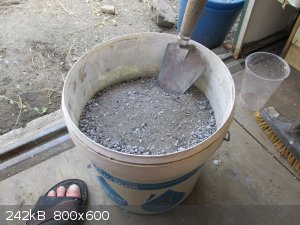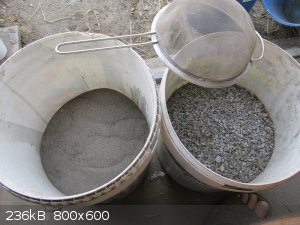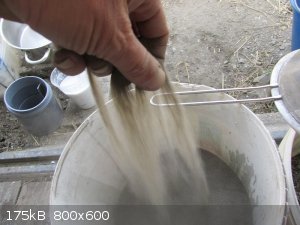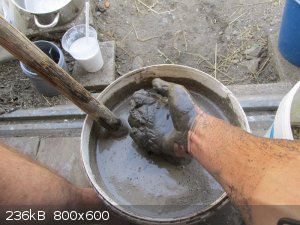| Pages:
1
2
3
4 |
deltaH
Dangerous source of unreferenced speculation
    
Posts: 1663
Registered: 30-9-2013
Location: South Africa
Member Is Offline
Mood: Heavily protonated
|
|
Okay, so who will volunteer to mix up a bucket of road dirt with some sodium hydroxide and water, settle, decant and boil down to the filtrate to see
what you get?
I suggest 30-50% road dirt by weight to water (depending on what you use to mix it with), and 1% sodium hydroxide by weight of dirt (might get away
with less, but this feels like a good value to start with).
One could also buy one of those paint mixing impellers from the hardware store and mix it with a power-drill in large plastic containers.
One might not even need to filter, just leave the bucket to stand overnight and then carefully decant the supernatant liquid from the settled solids.
[Edited on 2-6-2016 by deltaH]
|
|
|
aga
Forum Drunkard
    
Posts: 7030
Registered: 25-3-2014
Member Is Offline
|
|
Hi. I think we've met before 
So, for the dullest amongst us, the high pH will cause the nanoparticles of the stuff we want to end up in the Liquid bit yes ?
|
|
|
aga
Forum Drunkard
    
Posts: 7030
Registered: 25-3-2014
Member Is Offline
|
|
Wouldn't that mean that you can make organometallics with Pt, seeing as 'toxic' means it can be absorbed into living systems ?
If the organic molecule was reactive enough to Pt and Big enough, perhaps that'd defeat the 'stickiness' problem of the substrate.
|
|
|
deltaH
Dangerous source of unreferenced speculation
    
Posts: 1663
Registered: 30-9-2013
Location: South Africa
Member Is Offline
Mood: Heavily protonated
|
|
Quote: Originally posted by aga  |
So, for the dullest amongst us, the high pH will cause the nanoparticles of the stuff we want to end up in the Liquid bit yes ?
|
Yup, that's exactly correct.
|
|
|
aga
Forum Drunkard
    
Posts: 7030
Registered: 25-3-2014
Member Is Offline
|
|
I've identified a few low points on the autovia (highway/motorway) where the rain will have washed particles into a gulley, so i think that will be a
good place to start mining.
Also safer than sweeping the edge of the road.
Assuming that we can get anything at all, how is the presence of Pt to be tested ?
|
|
|
deltaH
Dangerous source of unreferenced speculation
    
Posts: 1663
Registered: 30-9-2013
Location: South Africa
Member Is Offline
Mood: Heavily protonated
|
|
Be careful to be sure your gulley has the 'pay dirt' and that it didn't wash away. I suppose it's prospecting after all, some spots will be rich,
others poor.
There is a kind of cheap furnace for melting jewellery DIY:
http://www.aliexpress.com/item/FREE-SHIPPING-Electric-Meltin...
Problem is these furnaces don't get anywhere near PGM melting temperatures.
Cody got it right by using lead metal as a 'solvent' to dissolve out the PGMs, the lead later oxidising away to lead dioxide and thus leaving behind
the PGM component, but I don't fancy having lead contaminating everything.
Maybe another metal could be used? This would need researching in the literature.
|
|
|
aga
Forum Drunkard
    
Posts: 7030
Registered: 25-3-2014
Member Is Offline
|
|
Well, 'prospecting' kind of Requires some way to tell if you found PayDirt.
No point sticking a heap of sand into a whole lot of Energy if there is no Pt in there (in this case).
Some method for detecting the presence of Pt would possibly be more of an 'invention' than processing the paydirt.
It'd certainly help find where the paydirt is.
|
|
|
careysub
International Hazard
    
Posts: 1339
Registered: 4-8-2014
Location: Coastal Sage Scrub Biome
Member Is Offline
Mood: Lowest quantum state
|
|
Here is a Bureau of Mines account of platinum assaying from 1920:
https://books.google.com/books?id=m7XPAAAAMAAJ&pg=PA48&a...
Quite a lot of work, it seems. There must be more modern methods?
|
|
|
deltaH
Dangerous source of unreferenced speculation
    
Posts: 1663
Registered: 30-9-2013
Location: South Africa
Member Is Offline
Mood: Heavily protonated
|
|
The most convenient method for fast ore assaying is probably x-ray fluorescence (XRF).
They even make handheld versions:
http://www.olympus-ims.com/en/xrf-xrd/delta-handheld/
Not cheap though 
You probably need to prospect for the rest of your life to pay that thing off lol
Then again, one might be able to MacGuyver an Arduino, x-ray tube and detector together to measure 'something', whether one would get useful results
is another matter.
[Edited on 4-6-2016 by deltaH]
|
|
|
deltaH
Dangerous source of unreferenced speculation
    
Posts: 1663
Registered: 30-9-2013
Location: South Africa
Member Is Offline
Mood: Heavily protonated
|
|
Aga will probably want to know how XRF works...
The innermost electrons of atoms are in low energy (more stable) orbitals whose values are largely independent of the chemical environment the atom
finds itself in (as opposed to higher energy valence electrons whose energy very much depends on the chemical environment it's in, i.e. the chemical
bond).
Anyway, the orbital energy of these innermost electrons are in the range of x-rays, so shining an x-ray of a higher energy onto elements causes some
of these innermost electrons to take up that photon and then be ejected from the atom (break orbit so to speak).
You are then left with a vacancy in that orbital of one electron. An electron from a more outer and higher energy orbital can then 'drop an orbit' or
multiple orbits to fill the vacancy in the core orbital. In doing so, it simultaneously emits a photon whose wavelength is the difference between it's
current orbital and the vacant one it enters. Remember, that the orbits around atoms are quantised and come in fixed increments.
These emitted or fluorescent photons are characteristic of the orbital energies for the atom and so can be used to infer what elements are present and
by calibration to intensity, how much.
[Edited on 4-6-2016 by deltaH]
|
|
|
aga
Forum Drunkard
    
Posts: 7030
Registered: 25-3-2014
Member Is Offline
|
|
Don't think i have any x-ray sources lying around.
Seems there has been much research on platinum recovery, which is no surprise.
https://www.jstage.jst.go.jp/article/rpsj/51/1/51_1_48/_pdf
|
|
|
deltaH
Dangerous source of unreferenced speculation
    
Posts: 1663
Registered: 30-9-2013
Location: South Africa
Member Is Offline
Mood: Heavily protonated
|
|
Interesting idea, but I still prefer a concentrate and smelt approach for simplicity.
I have seen clips on youtube where people build very simple arc furnaces, e.g.
https://www.youtube.com/watch?v=VTzKIs19eZE
This should get hot enough to smelt the concentrate directly, without any additives.
|
|
|
deltaH
Dangerous source of unreferenced speculation
    
Posts: 1663
Registered: 30-9-2013
Location: South Africa
Member Is Offline
Mood: Heavily protonated
|
|
The nice thing of using caustic soda to concentrate with is that the resulting solids will consist of an alkaline mix which ought to form molten
glasses with the materials used for catalyst support, so it should work great for smelting.
You just need to hit 1800C to melt platinum, but these simple electric arc can even melt tungsten if left long enough 
See https://www.youtube.com/watch?v=Ur_Ye2E_KoQ
|
|
|
unionised
International Hazard
    
Posts: 5135
Registered: 1-11-2003
Location: UK
Member Is Offline
Mood: No Mood
|
|
That's the claim, but I don't see why it's likely.
I can easily imagine that the Pt will stick to whatever is present that doesn't dissolve in the NaOH solution.
For example, there is going to be some rust, some rubber and some cellulose present in the road dust.
Why won't the Pt nanoparticles stick to those, rather than dissolving into the liquid phase?
|
|
|
deltaH
Dangerous source of unreferenced speculation
    
Posts: 1663
Registered: 30-9-2013
Location: South Africa
Member Is Offline
Mood: Heavily protonated
|
|
Quote: Originally posted by unionised  |
That's the claim, but I don't see why it's likely.
I can easily imagine that the Pt will stick to whatever is present that doesn't dissolve in the NaOH solution.
For example, there is going to be some rust, some rubber and some cellulose present in the road dust.
Why won't the Pt nanoparticles stick to those, rather than dissolving into the liquid phase?
|
I don't propose fully hydrolysing the catalyst support, just forming a colloidal solution by charging up the surfaces of the nanoparticles. There is a
difference.
The PGMs would either (a) continue to stick onto the colloidal particles of catalyst support or (b) if the conditions are such that they too are
repelled off the surface, then they will themselves remain in colloidal solution.
Think about it, if conditions are so extreme to repel the PGM particles off the surface of the catalyst support, those same conditions will not have
them stick to any other surface present in the dirt, they too would charge up at high pH!
|
|
|
aga
Forum Drunkard
    
Posts: 7030
Registered: 25-3-2014
Member Is Offline
|
|
Today around 21.5kg of roadside dirt was collected in a 15 litre recycled paint bucket.
To add to the excitement i counted the cars for 5 minutes : 93 passed by, on a sleepy Sunday afternoon.
After sieving, there was 9.0 kg of dust and 12.5kg of rubble, twigs, bits of plastic etc.
~12 litres of tap water was added to the finer dust-like portion and stirred with an axe-handle to mix.
Adding water to the dust makes it hard to stir. Better adding the dust to the water.
The mixture measured at pH 7.5.
The water here is very high in calcium/magnesium carbonates, so i suspect the dusty stuff is slightly acidic.
152g of NaOH was added, which brough the pH to 12.5
A further 57g and 114g were added (total 323g) raising the pH to 12.8
The mixture was then stirred for several minutes and left to settle overnight.
A beer was then cracked open and the photos uploaded 
   
|
|
|
battoussai114
Hazard to Others
  
Posts: 235
Registered: 18-2-2015
Member Is Offline
Mood: Not bad.... Not bad.
|
|
Aight, I want to try this too. Except it's been raining like hell (does it rain in hell?) 
Anyone knows how well Pt group particles seep into wet soil? There are these water retention lakes (tiny lakes, more like ponds) beside the roads here
and if the Pt doesn't go through soil very easily there should be extra high concentration in the bottom of these ponds, and I could easily get
samples once the weather gets sunny and the water evaporates.
[Edited on 5-6-2016 by battoussai114]
[Edited on 5-6-2016 by battoussai114]
Batoussai.
|
|
|
aga
Forum Drunkard
    
Posts: 7030
Registered: 25-3-2014
Member Is Offline
|
|
I did a quick survely of the roads here and they all have run-off water channels leading down to the rivers/sewers, which basically means that any Pt
in the rainwater will end up in the sea.
Your 'holding pond' sounds like a good place to get better Pt concentrations.
|
|
|
unionised
International Hazard
    
Posts: 5135
Registered: 1-11-2003
Location: UK
Member Is Offline
Mood: No Mood
|
|
Quote: Originally posted by deltaH  |
Think about it, if conditions are so extreme to repel the PGM particles off the surface of the catalyst support, those same conditions will not have
them stick to any other surface present in the dirt, they too would charge up at high pH! |
I did think about it.
You say "if conditions are so extreme to repel the PGM particles off the surface of the catalyst support..."
Well, what if they are not?
What if the Pt sticks to the remaining sludgy stuff?
What's to stop it doing so?
Do you know that road dust is full of carbon black, both fromunburned fuel and from rubber tyres?
There's no strong reason why it will develop any charge at all.
And it's a conductor. So, in principle electrostatic forces will attract any charge particles to the surface.
So there's lots of sticky carbon for the Pt to stick to.
Do you have a reason to think it won't, or is it just wishful thinking.
|
|
|
deltaH
Dangerous source of unreferenced speculation
    
Posts: 1663
Registered: 30-9-2013
Location: South Africa
Member Is Offline
Mood: Heavily protonated
|
|
Aga, this is wonderful! I'm excited to see what you recover from the supernatant liquid. Thank you for assisting with the
experimentation once again.
Your pH value sounds good, I think even 11 would have been ok. I would have tumbled or mixed the mud for some time to assist mechanically in breaking
up the agglomerated catalyst particles, call it a gentle milling, but let's see how this turns out as is.
Unionised, no, not wishful thinking. Carbon blacks charge up negatively and form colloidal solutions in even weakly alkaline
solutions, see http://pubs.acs.org/doi/full/10.1021/acs.langmuir.5b02017 (figure 2 and the paragraph preceding in particular).
| Quote: | | The carbon black and diesel soot particles formed stable colloidal suspensions when dispersed in water. Although not necessarily representative of
those suspensions formed in n-dodecane, such suspensions do enable aqueous electrophoresis studies to be conducted. The variation of both zeta
potential and intensity-average particle diameter with solution pH for both colloidal substrates is shown in Figure 2. Carbon black aggregates are
highly anionic (−30 to −45 mV) between pH 6 and pH 11. Below pH 6, the gradual reduction in surface charge leads to their progressive aggregation,
from an initial characteristic sphere-equivalent diameter of 200 nm in alkaline media to flocs of more than 800 nm at an isoelectric point (IEP) of
approximately pH 4.2 and micron-sized aggregates with appreciable cationic surface charge at pH 2–3. The diesel soot particles exhibit broadly
similar behavior, but with some subtle differences. The aggregates formed in alkaline media are somewhat larger, with sphere-equivalent diameters of
400–440 nm and zeta potentials of around −40 mV; they remain more or less stable from pH 11 to around pH 4, with an isoelectric point at
approximately pH 3. Micron-sized aggregates are formed between pH 2 and pH 3. |
The same hold for most other materials you might care to mention. Most materials exposed to the element have surfaces that are well oxidised. That
usually implies that their surfaces are peppered with -OH groups which are easily deprotonated at high pH, leading to negative charging and repulsion
of particle to particle.
Things just don't stick well at high pH, it's one of the first things I learned in chemistry.
|
|
|
aga
Forum Drunkard
    
Posts: 7030
Registered: 25-3-2014
Member Is Offline
|
|
Slight confusion over pH here and i appologise in advance to my most erstwhile tutors if i've messed this bit of maths up :
323g NaOH
=8.08 mols
12 litres of water
so [OH<sup>-</sup>] = 8.08/12 = 0.6733
pOH = -log(0.6733) = 0.1717 ~=0.2
pH = 14 - pOH
therefore the pH should be 13.8
... yet the digital meter reads a pH of 12.8.
Where did 3.42 x 10<sup>23</sup> ions of the OH<sup>-</sup> go ?
[Edited on 5-6-2016 by aga]
|
|
|
deltaH
Dangerous source of unreferenced speculation
    
Posts: 1663
Registered: 30-9-2013
Location: South Africa
Member Is Offline
Mood: Heavily protonated
|
|
There was probably something reacting with the very basic -OH to form something less basic, any number of inorganic oxides may have been responsible.
Wishfully thinking it is the catalyst support material  but probably not. but probably not.
It's a good sign, so don't worry about it. So long as your pH is above 10, I'd say we're good. I just hope you have enough supernatant liquid to
decant. Might need to filter if not.
The tough bit is going to be smelting the concentrate. I think the carbon electrode arc is your best bet and simplest to rig. You'd need a high
current source for the arc though, got a welding transformer or any largish transformer whose secondary you can rewind with thick cables?
The other challenge is going to be sourcing a high temperature refractory brick or making your own. NB. Get/make the type used for alkaline melts
since your concentrate will be highly alkaline, these are derived from magnesium oxide and not the white alumina silicates. if you use an alkaline
refractory, you won't need a crucible, just bore out the centre, careful not to crack it.
If you can only find the alumina-silicate bricks, then coat the inside with powdered magnesium oxide mixed with a little salted water. The chlorides
will cement the MgO particles together at high temperature while the partial hydrolysis when mixed with a little water will make the paste set after
mixing so that it temporarily stays put until you fire it for the first time.
|
|
|
aga
Forum Drunkard
    
Posts: 7030
Registered: 25-3-2014
Member Is Offline
|
|
How DARE they ?!?!
This bucket was clearly marked 'not for chemical reactions' so they have no excuses at all.
I will go and have a Word with them right now.
A stick welding rig exists as do various refractory bricks, so i just need some carbon rods.
I'd guestimate about 8 to 10 litres of supernatant.
[Edited on 5-6-2016 by aga]
|
|
|
deltaH
Dangerous source of unreferenced speculation
    
Posts: 1663
Registered: 30-9-2013
Location: South Africa
Member Is Offline
Mood: Heavily protonated
|
|
Fantastic news! Sounds like you have matters well in hand.
Don't worry if your supernatant doesn't turn completely clear, it's not supposed to. Colloids scatter light.
You just don't want the large particles of dirt when you decant. Hopefully you get a greyish liquid. If not, give it a swirl and wait only a few
minutes before decanting.
In fact, there might be no need to wait terribly long at all, just long enough to separate out the bulk of the big particles.
I'm clocking out for tonight.
[Edited on 5-6-2016 by deltaH]
|
|
|
deltaH
Dangerous source of unreferenced speculation
    
Posts: 1663
Registered: 30-9-2013
Location: South Africa
Member Is Offline
Mood: Heavily protonated
|
|
Quote: Originally posted by battoussai114  | Aight, I want to try this too. Except it's been raining like hell (does it rain in hell?) 
Anyone knows how well Pt group particles seep into wet soil? There are these water retention lakes (tiny lakes, more like ponds) beside the roads here
and if the Pt doesn't go through soil very easily there should be extra high concentration in the bottom of these ponds, and I could easily get
samples once the weather gets sunny and the water evaporates.
[Edited on 5-6-2016 by battoussai114]
[Edited on 5-6-2016 by battoussai114] |
battoussai114, sorry, but I do not know. I can speculate that since the PGM catalysts are made by impregnating low density supports
materials, the result is a low density material and so I would guess that they concentrate in the top layer of pond sediment? You'd have to try and
see.
|
|
|
| Pages:
1
2
3
4 |